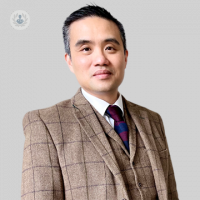Revolutionising knee surgery: The TWIS-TKR technique explained
Written by:The TWIS-TKR (Turn with Intelligent Stability Total Knee Replacement) technique in knee replacement surgery has emerged as a groundbreaking approach, revolutionising orthopaedic practices. Engineered to provide a more natural knee function and expedited recovery, TWIS-TKR combines custom kinematic alignment, artificial intelligence integration, and innovative recovery strategies. In his latest online article, Professor Paul Lee explores the intricacies of the TWIS-TKR technique, its suitability for candidates, benefits, patient outcomes, and how it compares to traditional knee replacement methods.

Understanding the TWIS-TKR technique:
The TWIS-TKR technique focuses on achieving custom kinematic rotation alignment, mimicking the natural movements of the knee. This precision ensures optimal rotational alignment and intelligent stability, ultimately providing patients with improved functionality and reduced post-surgical complications. The integration of artificial intelligence from MAI-Motion enhances surgical planning and execution, tailoring the procedure to each patient's unique anatomical and functional needs.
Who is a good candidate for TWIS-TKR?
Ideal candidates for the TWIS-TKR technique are those seeking customised solutions and precision in surgical planning. This includes individuals with unique knee joint structures, chronic knee pain, moderate to severe knee deformities, or a history of failed previous knee surgeries. Good overall health, realistic expectations, and a commitment to post-operative care are essential criteria for potential candidates.
Improving patient outcomes:
Clinical evidence supports the effectiveness of TWIS-TKR, demonstrating improved functional outcomes, enhanced patient satisfaction, reduced complication rates, and accelerated recovery times. Patients experience a more natural knee function, quicker return to normal activities, and reduced pain post-surgery. The technique's biomechanical advantages, coupled with AI-driven precision, contribute to its longevity and effectiveness.
Innovation in orthopaedic surgery:
TWIS-TKR, pioneered by Professor Paul Lee, stands out as an innovative approach in orthopaedic surgery. The custom rotational alignment, integration of artificial intelligence, enhanced mobility and stability, improved functional outcomes, reduced complication rates, faster recovery, biomechanical advantages, and a holistic approach to patient care collectively contribute to its innovative nature.
Comparing recovery time with traditional methods:
TWIS-TKR demonstrates a significantly expedited recovery compared to traditional knee replacement methods. Patients experience improved mobility, stability, and a quicker return to normal activities. Comparative studies reveal lower complication rates, shorter hospital stays, and reduced post-operative pain management needs. In contrast, traditional knee replacements generally require up to a year for full recovery, with most patients resuming normal activities about six weeks post-surgery.
Professor Paul Lee is a highly respected orthopaedic surgeon with over 15 years of experience. You can schedule an appointment with Professor Lee on his Top Doctors profile.


